Workplace Mental State Monitoring during VR-Based Training for Offshore Environment
Abstract
:1. Introduction
Motivation of Study
2. VR-Based Training for Offshore Environment
2.1. Virtual Environment for Offshore Training
2.1.1. Module 1—Oil Sampling
2.1.2. Module 2—Confined Space Inspection
2.1.3. Module 3—Pipeline Valve Rotation
2.1.4. Module 4—Crane Training
3. Mental State Monitoring during VR Training
3.1. User Experience and Performance Assessments
3.2. Mental State Assessment Using EEG
EEG Analysis
4. Results
4.1. User Experience Assessment
4.2. Performance Assessment
4.3. Mental State Assessment
4.3.1. Theta Activity
4.3.2. Alpha Activity
4.3.3. Beta Activity
4.3.4. Alpha Asymmetry
5. Discussion
5.1. Advantages and Drawbacks of VR
5.2. Presence of Stress
5.3. Learning under Stress
6. Conclusions
Author Contributions
Funding
Institutional Review Board Statement
Informed Consent Statement
Data Availability Statement
Acknowledgments
Conflicts of Interest
References
- Ursin, H.; Eriksen, H.R. The cognitive activation theory of stress. Psychoneuroendocrinology 2004, 29, 567–592. [Google Scholar] [CrossRef]
- Kassim, M.S.A.; Ismail, A.; Ismail, R. A Review of Occupational Stress Prevalence and its Predictors among Selected Working Populations in Malaysia. Malays. J. Public Health Med. 2018, 18, 1–6. [Google Scholar]
- Fink, G. Stress: Concepts, Cognition, Emotion, and Behavior; Handbook of Stress Series; Academic Press: Salt Lake City, UT, USA, 2016; Volume 1. [Google Scholar]
- Varma, P.; Junge, M.; Meaklim, H.; Jackson, M.L. Younger people are more vulnerable to stress, anxiety and depression during COVID-19 pandemic: A global cross-sectional survey. Prog.-Neuro-Psychopharmacol. Biol. Psychiatry 2021, 109, 110236. [Google Scholar] [CrossRef]
- Sharma, N.; Gedeon, T. Objective measures, sensors and computational techniques for stress recognition and classification: A survey. Comput. Methods Programs Biomed. 2012, 108, 1287–1301. [Google Scholar] [CrossRef]
- Vanitha, V.; Krishnan, P. Real time stress detection system based on EEG signals. Biomed. Res. Comput. Life Sci. Smarter Technol. Adv. 2016, 2016, S271–S275. [Google Scholar]
- Marshall, A.C.; Cooper, N.R. The association between high levels of cumulative life stress and aberrant resting state EEG dynamics in old age. Biol. Psychol. 2017, 127, 64–73. [Google Scholar] [CrossRef]
- Naqvi, S.F.; Ali, S.S.A.; Yahya, N.; Yasin, M.A.; Hafeez, Y.; Subhani, A.R.; Adil, S.H.; Saggaf, U.M.A.; Moinuddin, M. Real-Time Stress Assessment Using Sliding Window Based Convolutional Neural Network. Sensors 2020, 20, 4400. [Google Scholar] [CrossRef]
- Giannopulu, I. Neuroscience, Robotics and Virtual Reality: Internalised vs Externalised Mind/Brain; Springer: Cham, Switzerland, 2018; Volume 1. [Google Scholar]
- Saposnik, G.; Cohen, L.G.; Mamdani, M.; Pooyania, S.; Ploughman, M.; Cheung, D.; Shaw, J.; Hall, J.; Nord, P.; Dukelow, S.; et al. Efficacy and safety of non-immersive virtual reality exercising in stroke rehabilitation (EVREST): A randomised, multicentre, single-blind, controlled trial. Lancet Neurol. 2016, 15, 1019–1027. [Google Scholar] [CrossRef] [Green Version]
- Calabrò, R.S.; Naro, A.; Russo, M.; Leo, A.; Luca, R.D.; Balletta, T.; Buda, A.; Rosa, G.L.; Bramanti, A.; Bramanti, P. The role of virtual reality in improving motor performance as revealed by EEG: Randomized clinical trial. J. Neuroeng. Rehabil. 2017, 1–16. [Google Scholar] [CrossRef] [PubMed]
- Hafeez, Y.; Ali, S.S.A.; Mumtaz, W.; Moinuddin, M.; Adil, S.H.; Al-Saggaf, U.M.; Yasin, M.A.M.; Malik, A.S. Investigating Neurofeedback Protocols for Stress Mitigation: A Comparative Analysis of Different Stimulus Contents. IEEE Access 2019. [Google Scholar] [CrossRef]
- binti Sulaiman, S.; Ali, S.S.A.; Adil, S.H.; Ebrahim, M.; Raza, K. Virtual Reality Training and Skill Enhancement for Offshore Workers. In Proceedings of the 2020 International Conference on Computational Intelligence (ICCI), Bandar Seri Iskandar, Malaysia, 8–9 October 2020; pp. 287–292. [Google Scholar] [CrossRef]
- Holm, R.; Priglinger, M. Virtual Reality Training as a Method for Interactive and Experience-based Learning. In Proceedings of the SPE Intelligent Energy International Conference and Exhibition, Amsterdam, The Netherlands, 25–28 February 2008. [Google Scholar] [CrossRef]
- Grajewski, D.; Górski, F.; Hamrol, A.; Zawadzki, P. Immersive and Haptic Educational Simulations of Assembly Workplace Conditions. Procedia Comput. Sci. 2015, 75, 359–368. [Google Scholar] [CrossRef] [Green Version]
- Khedher, A.B.; Jraidi, I.; Frasson, C. Tracking Students’ Mental Engagement Using EEG Signals during an Interaction with a Virtual Learning Environment. J. Intell. Learn. Syst. Appl. 2019, 11. [Google Scholar] [CrossRef] [Green Version]
- Wan, B.; Wang, Q.; Su, K.; Dong, C.; Song, W.; Pang, M. Measuring the Impacts of Virtual Reality Games on Cognitive Ability Using EEG Signals and Game Performance Data. IEEE Access 2021, 9, 18326–18344. [Google Scholar] [CrossRef]
- Magosso, E.; De Crescenzio, F.; Ricci, G.; Piastra, S.; Ursino, M. EEG Alpha Power Is Modulated by Attentional Changes during Cognitive Tasks and Virtual Reality Immersion. Comput. Intell. Neurosci. 2019, 2019, 7051079. [Google Scholar] [CrossRef] [Green Version]
- Dan, A.; Reiner, M. EEG-based cognitive load of processing events in 3D virtual worlds is lower than processing events in 2D displays. Int. J. Psychophysiol. 2017, 122, 75–84. [Google Scholar] [CrossRef]
- Tremmel, C.; Herff, C.; Sato, T.; Rechowicz, K.; Yamani, Y.; Krusienski, D.J. Estimating Cognitive Workload in an Interactive Virtual Reality Environment Using EEG. Front. Hum. Neurosci. 2019, 13, 401. [Google Scholar] [CrossRef]
- Fadeev, K.A.; Smirnov, A.S.; Zhigalova, O.P.; Bazhina, P.S.; Tumialis, A.V.; Golokhvast, K.S. Too Real to Be Virtual: Autonomic and EEG Responses to Extreme Stress Scenarios in Virtual Reality. Behav. Neurol. 2020, 2020, 5758038. [Google Scholar] [CrossRef]
- D’Errico, F.; Leone, G.; Schmid, M.; D’Anna, C. Prosocial Virtual Reality, Empathy, and EEG Measures: A Pilot Study Aimed at Monitoring Emotional Processes in Intergroup Helping Behaviors. Appl. Sci. 2020, 10, 1196. [Google Scholar] [CrossRef] [Green Version]
- Kosunen, I.; Salminen, M.; Järvelä, S.; Ruonala, A.; Ravaja, N.; Jacucci, G. RelaWorld: Neuroadaptive and Immersive Virtual Reality Meditation System. In Proceedings of the 21st International Conference on Intelligent User Interfaces, Sonoma, CA, USA, 7–10 March 2016; ACM: New York, NY, USA, 2016; pp. 208–217. [Google Scholar] [CrossRef]
- Rose, T.; Nam, C.S.; Chen, K.B. Immersion of virtual reality for rehabilitation-Review. Appl. Ergon. 2018, 69, 153–161. [Google Scholar] [CrossRef] [PubMed]
- Amores, J.; Richer, R.; Zhao, N.; Maes, P.; Eskofier, B.M. Promoting relaxation using virtual reality, olfactory interfaces and wearable EEG. In Proceedings of the 2018 IEEE 15th International Conference on Wearable and Implantable Body Sensor Networks (BSN), Las Vegas, NV, USA, 4–7 March 2018; pp. 98–101. [Google Scholar] [CrossRef] [Green Version]
- Perhakaran, G.; Yusof, A.M.; Rusli, M.E.; Yusoff, M.Z.M.; Mahalil, I.; Zainuddin, A.R.R. A Study of Meditation Effectiveness for Virtual Reality Based Stress Therapy Using EEG Measurement and Questionnaire Approaches. In Innovation in Medicine and Healthcare 2015; Chen, Y.W., Torro, C., Tanaka, S., Howlett, R.J., Jain, L.C., Eds.; Springer International Publishing: Cham, Switzerland, 2016; pp. 365–373. [Google Scholar]
- Gu, G.; Frasson, C. Virtual Sophrologist: A Virtual Reality Neurofeedback Relaxation Training System. In Brain Function Assessment in Learning; Frasson, C., Kostopoulos, G., Eds.; Springer International Publishing: Cham, Switzerland, 2017; pp. 176–185. [Google Scholar]
- Prpa, M.; Cochrane, K.; Riecke, B.E. Hacking Alternatives in 21st Century: Designing a Bio-Responsive Virtual Environment for Stress Reduction. In Pervasive Computing Paradigms for Mental Health; Serino, S., Matic, A., Giakoumis, D., Lopez, G., Cipresso, P., Eds.; Springer International Publishing: Cham, Switzerland, 2016; pp. 34–39. [Google Scholar]
- Bastos, I.L.M.; Faria, M.G.d.A.; Koopmans, F.F.; Alves, L.V.V.; Mello, A.S.d.; David, H.M.S.L. Risks, injuries, and illnesses among professionals working on offshore platforms: An integrative review. Rev. Eletr. Enferm. 2020, 22. [Google Scholar] [CrossRef]
- Farmer, M. How the Covid-19 Coronavirus Is Affecting the Offshore Industry. 2020. Available online: https://www.offshore-technology.com/features/coronavirus-impact-offshore/ (accessed on 22 March 2021).
- Wells, C.R.; Townsend, J.P.; Pandey, A.; Moghadas, S.M.; Krieger, G.; Singer, B.; McDonald, R.H.; Fitzpatrick, M.C.; Galvani, A.P. Optimal COVID-19 quarantine and testing strategies. Nat. Commun. 2021, 12, 356. [Google Scholar] [CrossRef]
- GlobalData. How Leading Oil and Gas Companies Are Adopting Virtual Reality. 2020. Available online: https://www.offshore-technology.com/comment/oil-gas-virtual-reality/ (accessed on 22 March 2021).
- GlobalData. Virtual Reality in Oil and Gas: Key Trends Revealed. 2020. Available online: https://www.offshore-technology.com/comment/virtual-reality-in-oil-and-gas-key-trends-revealed/ (accessed on 22 March 2021).
- Perez, B.Z.; Marin, M.M.; Perez, E.I. Developing a Virtual Environment for Safety Training. In Proceedings of the Electronics, Robotics and Automotive Mechanics Conference (CERMA 2007), Cuernavaca, Mexico, 25–28 September 2007; pp. 545–550. [Google Scholar] [CrossRef]
- George, A.K.; McLain, M.L.; Bijlani, K.; Jayakrishnan, R.; Bhavani, R.R. A Novel Approach for Training Crane Operators: Serious Game on Crane Simulator. In Proceedings of the 2016 IEEE Eighth International Conference on Technology for Education (T4E), Mumbai, India, 2–4 December 2016; pp. 116–119. [Google Scholar] [CrossRef]
- Dong, H.; Xu, G. An Expert System for Bridge Crane Training System Based on Virtual Reality. In Proceedings of the 2010 International Conference on Artificial Intelligence and Computational Intelligence, Sanya, China, 23–24 October 2010; Volume 3, pp. 30–33. [Google Scholar] [CrossRef]
- Koo, M.W.; Ha, S.; Cha, J.H.; Cho, D.Y. Fire Incident Training for Offshore Worker Using Virtual Reality. In Proceedings of the International Ocean and Polar Engineering Conference, San Francisco, CA, USA, 25–30 June 2017; pp. 886–890. [Google Scholar]
- Saghafian, M.; Laumann, K.; Akhtar, R.S.; Skogstad, M.R. The Evaluation of Virtual Reality Fire Extinguisher Training. Front. Psychol. 2020, 11, 3137. [Google Scholar] [CrossRef]
- Duncan, R. The Potential Contribution of Augmented and Virtual Reality to the Oil and Gas Industry. Int. J. Manag. Appl. Res. 2015, 2, 112–120. [Google Scholar] [CrossRef] [Green Version]
- Xu, X.; Li, Z.; Wang, L.; Yao, S.; Fang, X. Interactive Visual Reality of the Offshore Hoisting Operation and Numerical Modeling. Int. J. Pattern Recognit. Artif. Intell. 2018, 32, 1855012. [Google Scholar] [CrossRef]
- Patle, D.S.; Manca, D.; Nazir, S.; Sharma, S. Operator training simulators in virtual reality environment for process operators: A review. Virtual Real. 2019, 23, 293–311. [Google Scholar] [CrossRef]
- Pusey, M.; Wong, K.W.; Rappa, N.A. Resilience interventions using interactive technology: A scoping review. Interact. Learn. Environ. 2020, 1–16. [Google Scholar] [CrossRef]
- Montana, J.I.; Matamala-Gomez, M.; Maisto, M.; Mavrodiev, P.A.; Cavalera, C.M.; Diana, B.; Mantovani, F.; Realdon, O. The Benefits of emotion Regulation Interventions in Virtual Reality for the Improvement of Wellbeing in Adults and Older Adults: A Systematic Review. J. Clin. Med. 2020, 9, 500. [Google Scholar] [CrossRef] [Green Version]
- Bruggeman, K.J. Creating Biofeedback-Based Virtual Reality Applications to Enhance Coherence of Mindfulness Practice. Ph.D. Thesis, The Ohio State University, Columbus, OH, USA, 2019. [Google Scholar]
- Winkler, I.; Haufe, S.; Tangermann, M. Automatic Classification of Artifactual ICA-Components for Artifact Removal in EEG Signals. Behav. Brain Funct. 2011, 7, 30. [Google Scholar] [CrossRef] [Green Version]
- Delorme, A.; Makeig, S. EEGLAB: An open source toolbox for analysis of single-trial EEG dynamics including independent component analysis. J. Neurosci. Methods 2004, 134, 9–21. [Google Scholar] [CrossRef] [Green Version]
- Heo, J.; Yoon, G. EEG Studies on Physical Discomforts Induced by Virtual Reality Gaming. J. Electr. Eng. Technol. 2020, 15, 1323–1329. [Google Scholar] [CrossRef]
- Hoffmann, E. Brain Training against Stress; Technical report; Mental Fitness & Forskningscenter: Copenhagen, Denmark, 2005. [Google Scholar]
- Hafeez, Y.; Ali, S.S.A.; Malik, A.S. Neurofeedback training content for treatment of stress. In Proceedings of the 2016 IEEE EMBS Conference on Biomedical Engineering and Sciences (IECBES), Kuala Lumpur, Malaysia, 4–8 December 2016; pp. 133–137. [Google Scholar] [CrossRef]
- Hillard, B. Analysis of Eeg Rhythms Using Custom-made Matlab Applicationfor Processing of Data Collected during Neurofeedback Training in Adhd Subjects. Master’s Thesis, University of Louisville, Louisville, KY, USA, 2011. [Google Scholar]
- Wang, Y.; Sokhadze, E.M.; El-Baz, A.S.; Li, X.; Sears, L.; Casanova, M.F.; Tasman, A. Relative Power of Specific EEG Bands and Their Ratios during Neurofeedback Training in Children with Autism Spectrum Disorder. Front. Hum. Neurosci. 2016, 9, 723. [Google Scholar] [CrossRef] [PubMed]
- Tarrant, J.; Viczko, J.; Cope, H. Virtual Reality for Anxiety Reduction Demonstrated by Quantitative EEG: A Pilot Study. Front. Psychol. 2018, 9, 1280. [Google Scholar] [CrossRef] [Green Version]
- Brouwer, A.M.; Neerincx, M.A.; Kallen, V.; van der Leer, L.; ten Brinke, M. EEG Alpha Asymmetry, Heart Rate Variability and Cortisol in Response to Virtual Reality Induced Stress. J. Cybertherapy Rehabil. 2011, 4, 27–40. [Google Scholar]
- Al-shargie, F.; Tang, T.B.; Badruddin, N.; Kiguchi, M. Towards multilevel mental stress assessment using SVM with ECOC: An EEG approach. Med Biol. Eng. Comput. 2017, 56, 125–136. [Google Scholar] [CrossRef] [PubMed]
- Lehrer, P.M.; Woolfolk, R.L.; Sime, W.E. (Eds.) Principles and Practice of Stress Management; The Guilford Press: New York, NY, USA, 2007. [Google Scholar]
- Thye, T.S.L.L. Work Stress and Mental Health. Available online: https://www.nst.com.my/news/2016/04/142074/work-stress-and-mental-health (accessed on 22 March 2021).
- Kwon, K.A.; Jeon, S.; Jeon, L.; Castle, S. The role of teachers’ depressive symptoms in classroom quality and child developmental outcomes in Early Head Start programs. Learn. Individ. Differ. 2019, 74, 101748. [Google Scholar] [CrossRef]
- Penn, R.A.; Hout, M.C. Making Reality Virtual: How VR “Tricks” Your Brain. Front. Young Minds 2018, 6. [Google Scholar] [CrossRef] [Green Version]
- Liao, C.Y.; Tai, S.K.; Chen, R.C.; Hendry, H. Using EEG and Deep Learning to Predict Motion Sickness Under Wearing a Virtual Reality Device. IEEE Access 2020, 8, 126784–126796. [Google Scholar] [CrossRef]
- Jatoi, M.A.; Kamel, N. Brain Source Localization Using EEG Signal Analysis; CRC Press: Boca Raton, FL, USA, 2018. [Google Scholar]
- Kamel, N.; Malik, A.S. (Eds.) EEG/ERP Analysis; CRC Press: Boca Raton, FL, USA, 2015. [Google Scholar]
- Louis, E.K.S.; Frey, L.C. (Eds.) Electroencephalography (EEG): An Introductory Text and Atlas of Normal and Abnormal Findings in Adults, Children, and Infants; American Epilepsy Society: Chicago, IL, USA, 2016. [Google Scholar]
- Mari-Acevedo, J.; Yelvington, K.; Tatum, W.O.; Levin, K.H.; Chauvel, P. Chapter 9—Normal EEG variants. In Handbook of Clinical Neurology; Elsevier: Amsterdam, The Netherlands, 2019; Volume 160, pp. 143–160. [Google Scholar]
- Kovacevic, N.; Ritter, P.; Tays, W.; Moreno, S.; McIntosh, A.R. ‘My Virtual Dream’: Collective Neurofeedback in an Immersive Art Environment. PLoS ONE 2015, 10, 1–18. [Google Scholar] [CrossRef]
- Kamiński, J.; Brzezicka, A.; Gola, M.; Wróbel, A. Beta band oscillations engagement in human alertness process. Int. J. Psychophysiol. 2012, 85, 125–128. [Google Scholar] [CrossRef]
- Vernon, D.; Egner, T.; Cooper, N.; Compton, T.; Neilands, C.; Sheri, A.; Gruzelier, J. The effect of training distinct neurofeedback protocols on aspects of cognitive performance. Int. J. Psychophysiol. 2003, 47, 75–85. [Google Scholar] [CrossRef]
- Kiiski, H.; Bennett, M.; Rueda-Delgado, L.M.; Farina, F.R.; Knight, R.; Boyle, R.; Roddy, D.; Grogan, K.; Bramham, J.; Kelly, C.; et al. EEG spectral power, but not theta/beta ratio, is a neuromarker for adult ADHD. Eur. J. Neurosci. 2019, 51, 2095–2109. [Google Scholar] [CrossRef] [PubMed]
- Hafeez, Y.; Ali, S.S.A.; Faraz, S.; Moinuddin, M.; Adil, S.H. Effect of Neurofeedback 2D and 3D Stimulus Content On Stress Mitigation. In Proceedings of the 2019 IEEE Student Conference on Research and Development (SCOReD), Bandar Seri Iskandar, Malaysia, 15–17 October 2019; pp. 289–293. [Google Scholar] [CrossRef]
- Vukelić, M.; Gharabaghi, A. Oscillatory entrainment of the motor cortical network during motor imagery is modulated by the feedback modality. NeuroImage 2015, 111, 1–11. [Google Scholar] [CrossRef] [PubMed]

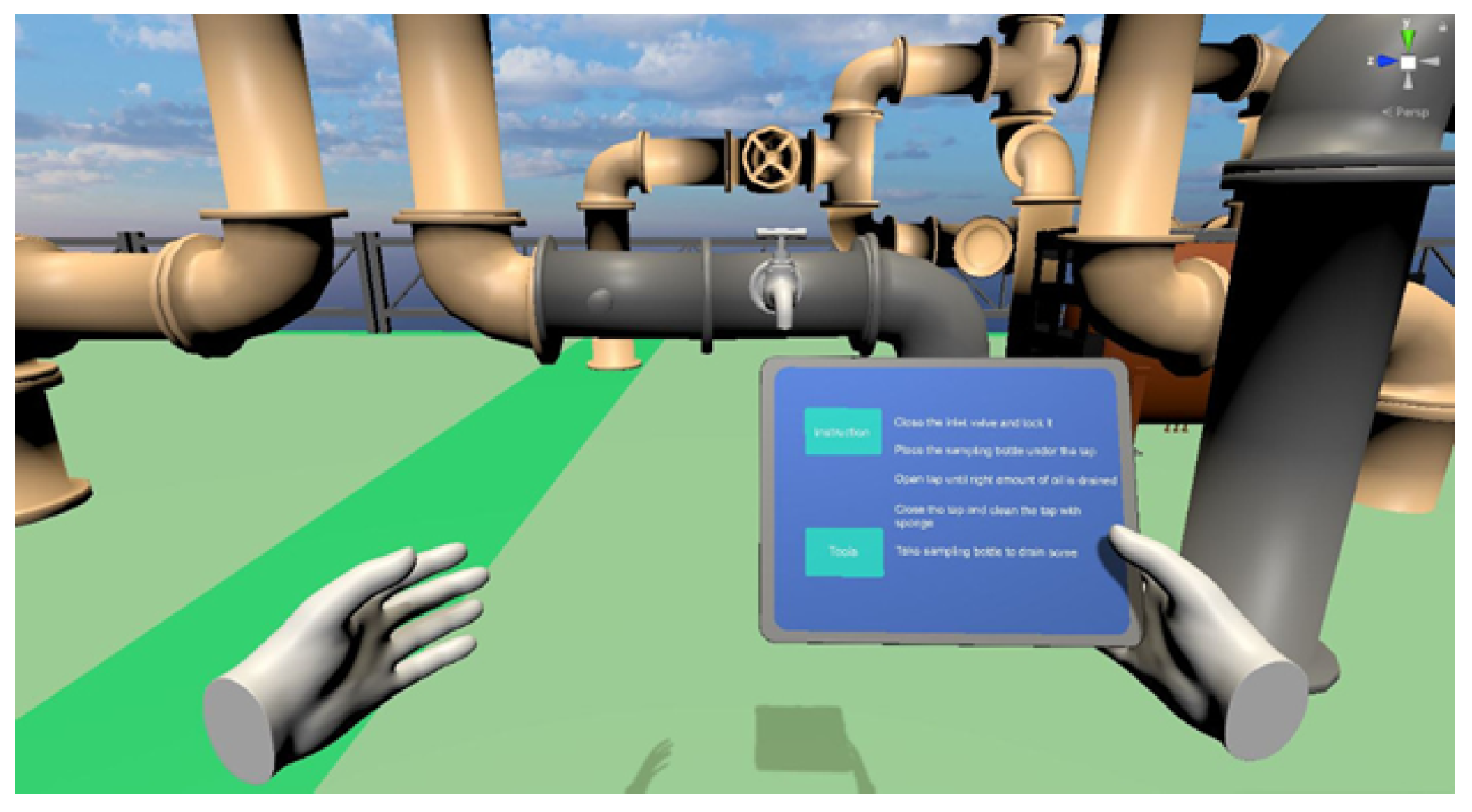


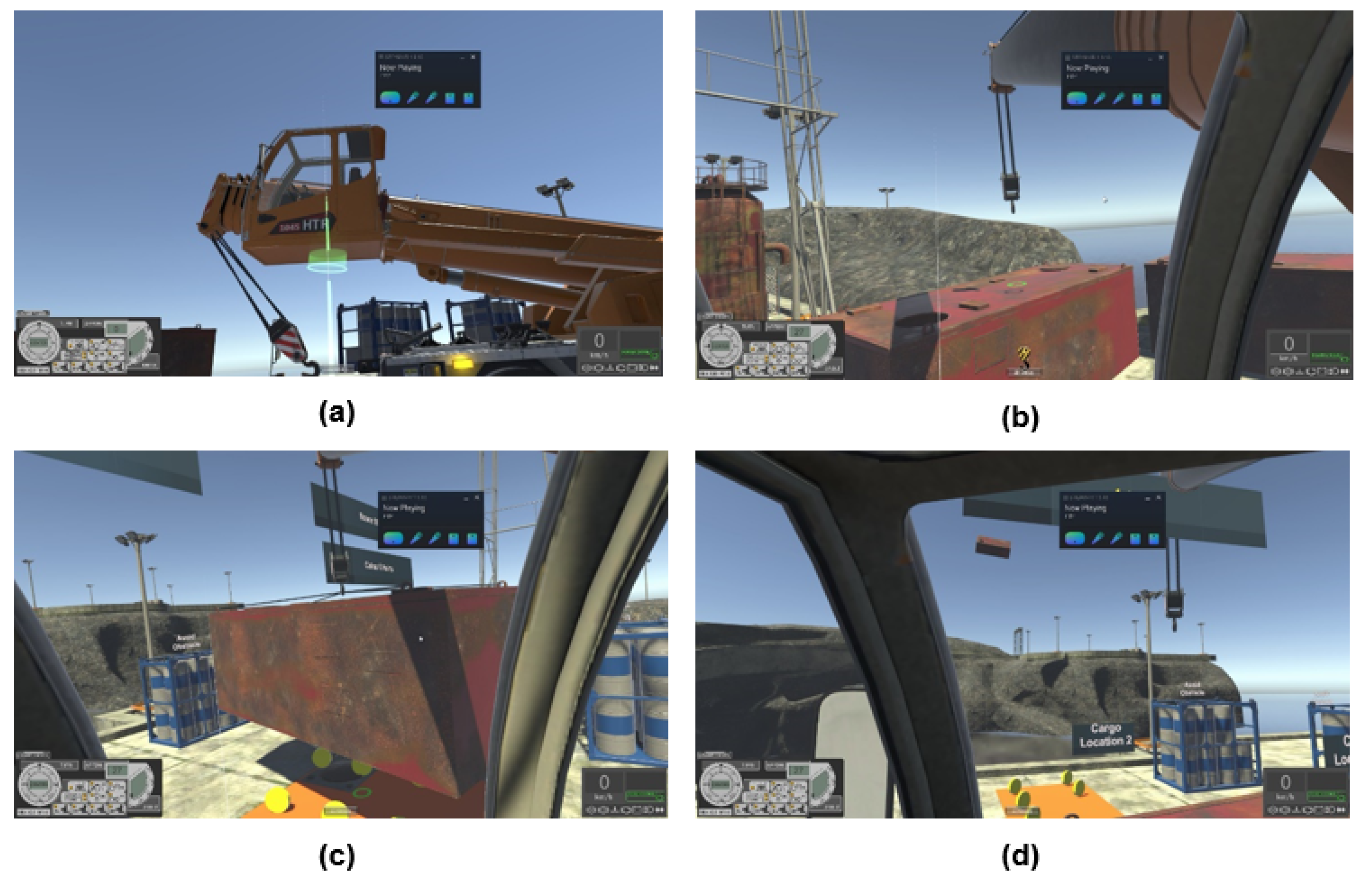

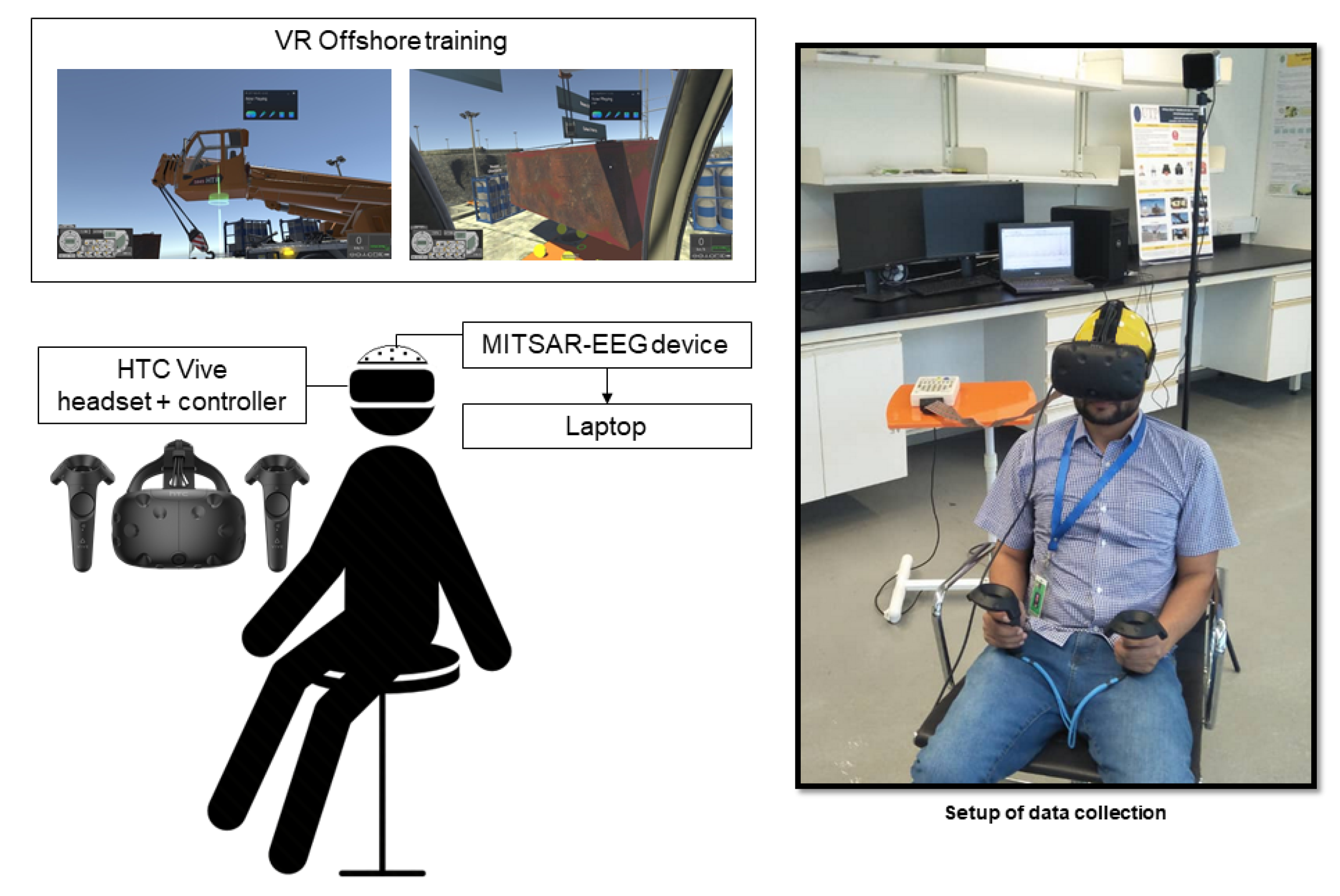
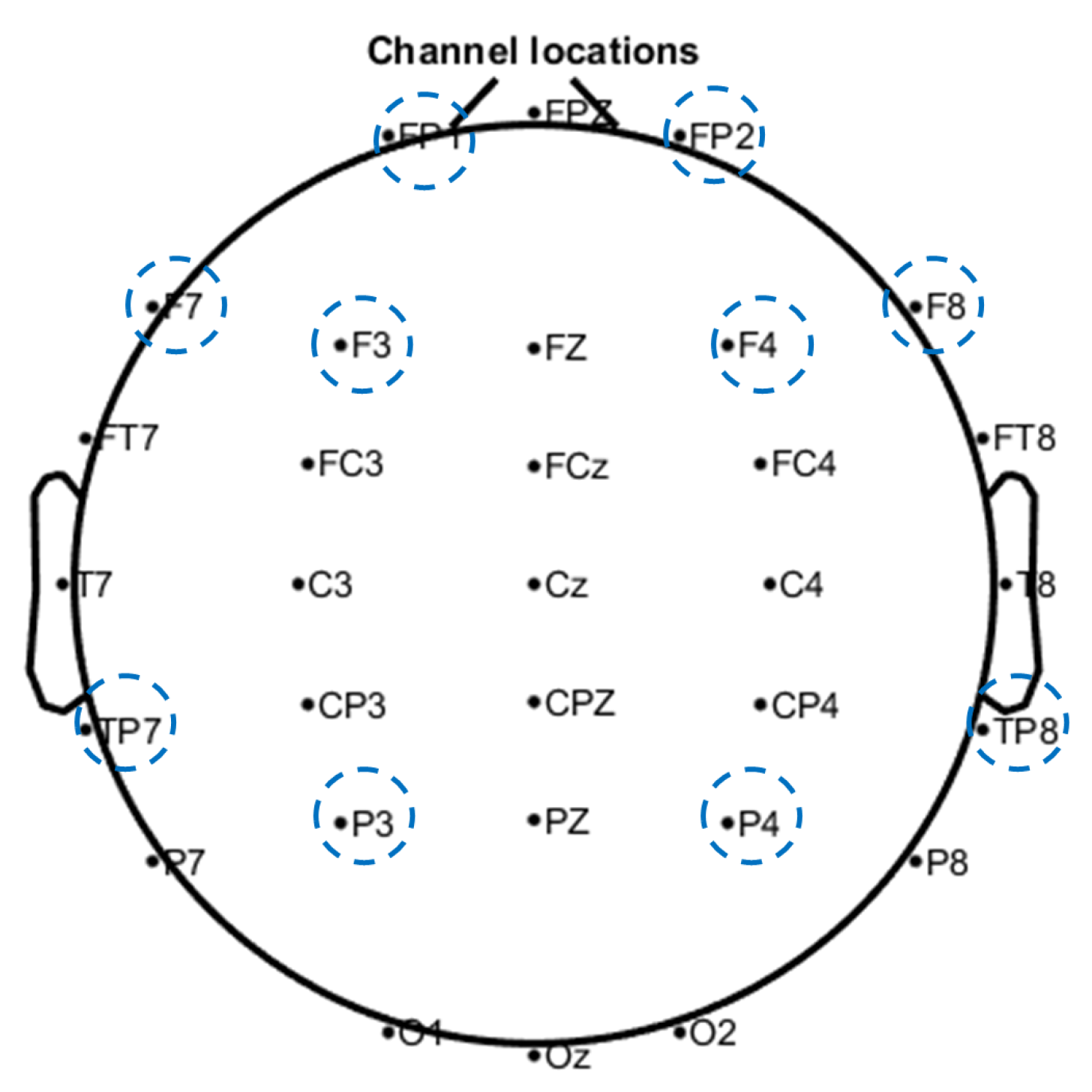

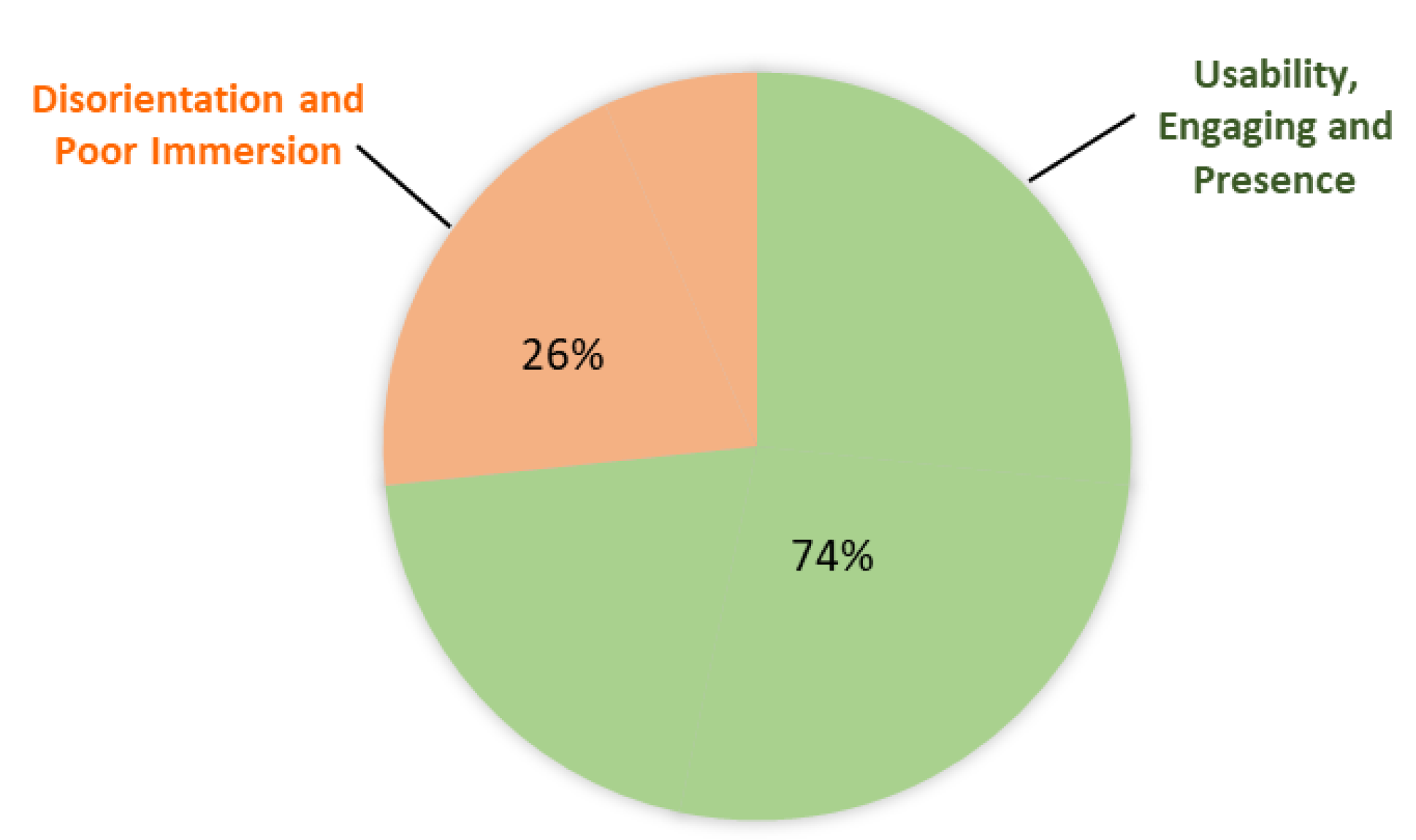

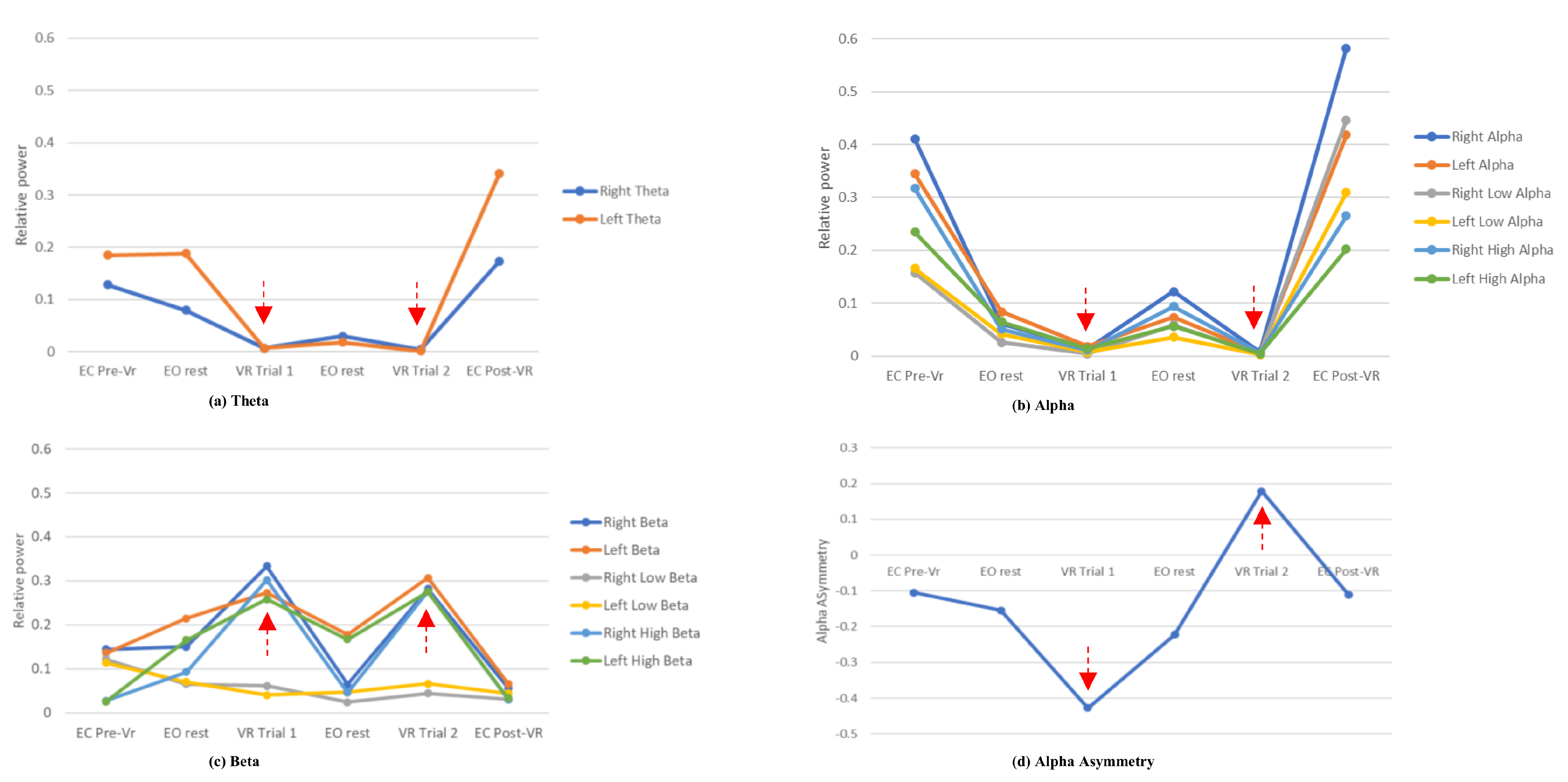

| User Experience | Response | |
|---|---|---|
| Usability | − | The training is easy to understand |
| Engaging | − | Excited to try another virtual training |
| Presence | − | It helps me to overcome my claustrophobia |
| Disorientation | − | I got motion sickness from the VR headset |
| Immersive | − | The experience is not immersive enough |
| EEG Wave | Brain Area | Electrode | Stress Response | Sub-Band |
|---|---|---|---|---|
| Theta [47] | Temporo-parietal | TP7,TP8 | Discomfort, disorientation | − |
| Alpha [52] | Frontal | Fp1,Fp2,F3, | Relaxed and calm | Low |
| F4,F7,F8 | Relaxed and alert | High | ||
| Beta [52] | Parietal | P3,P4 | Concentration | Low |
| Concentration and anxiety | High |
| Characteristic | N = 21 |
|---|---|
| Age | 27 ± 5.90 |
| Gender | 9 males, 12 females |
| Tertiary Education Field | Engineering |
| Normal or corrected-to-normal vision | Yes |
| Neurological and physiological complication | No |
Publisher’s Note: MDPI stays neutral with regard to jurisdictional claims in published maps and institutional affiliations. |
© 2021 by the authors. Licensee MDPI, Basel, Switzerland. This article is an open access article distributed under the terms and conditions of the Creative Commons Attribution (CC BY) license (https://creativecommons.org/licenses/by/4.0/).
Share and Cite
Abu Hasan, R.; Sulaiman, S.; Ashykin, N.N.; Abdullah, M.N.; Hafeez, Y.; Ali, S.S.A. Workplace Mental State Monitoring during VR-Based Training for Offshore Environment. Sensors 2021, 21, 4885. https://doi.org/10.3390/s21144885
Abu Hasan R, Sulaiman S, Ashykin NN, Abdullah MN, Hafeez Y, Ali SSA. Workplace Mental State Monitoring during VR-Based Training for Offshore Environment. Sensors. 2021; 21(14):4885. https://doi.org/10.3390/s21144885
Chicago/Turabian StyleAbu Hasan, Rumaisa, Shahida Sulaiman, Nur Nabila Ashykin, Mohd Nasir Abdullah, Yasir Hafeez, and Syed Saad Azhar Ali. 2021. "Workplace Mental State Monitoring during VR-Based Training for Offshore Environment" Sensors 21, no. 14: 4885. https://doi.org/10.3390/s21144885
APA StyleAbu Hasan, R., Sulaiman, S., Ashykin, N. N., Abdullah, M. N., Hafeez, Y., & Ali, S. S. A. (2021). Workplace Mental State Monitoring during VR-Based Training for Offshore Environment. Sensors, 21(14), 4885. https://doi.org/10.3390/s21144885







